Learning Objectives #
Upon completion of this module students will:
1. be familiar with the functions of the skin.
2. understand the factors affecting skin integrity.
3. master the principles of skin care.
4. identify the risk factors for skin breakdown.
5. identify preventative measures.
6. identify high risk groups.
Wound Prevention. #
Introduction #
The challenges of skin care and wound prevention.
This unit is designed to assist you with basic skin care including the assessment and prevention of skin breakdown. By the end of this unit you will:
- Be familiar with the functions of skin
- Understand the factors affecting skin integrity
- Master the principles of skin care
- Identify the risk factors for skin breakdown
- Identify preventative measures
- Identify high risk groups
Functions of Skin #
There are six functions of skin that will be discussed briefly in this unit. These include:
Protection
Skin provides protection by acting as the first line of defense against invading organisms.
Thermoregulation
Skin helps with thermoregulation by perspiring when we are hot and shivering when we are cold.
Elimination of Waste
Skin allows for the elimination of waste through its pores.
Communication and Sensation
The skin also senses irritants or painful stimuli that maybe invading. This sensation is then communicated from the skin to the brain, which tells us to move or shift from the potential danger.
Synthesis of Vitamin D
Another important function of the skin is the synthesis of Vitamin D.
Factors affecting the skin #
These factors can affect the functions of skin:
- Age
- Environment
- Nutritional status
- Dryness
- Hydration
Aged Skin versus Young Skin
- Age related changes that interfere with the functions of skin include:Increased dryness, which increases the risk of skin cracking.
- Decreased sebum. Sebum, a lipid, helps to keep moisture in by acting as a barrier in between cells.
- Epidermal thinning. This is the outer layer of skin, so the thinner it is the weaker the barrier.
- Flattened rete ridges. Rete ridges help adhere the epidermis to the dermis. Therefore, once these become flattened, the adherence decreases increasing the risk of skin tears.
- Loss of elasticity, which leads to wrinkling and the inability of skin to snap back into its original shape.
- Decreased tissue tolerance, meaning the skin is less able to tolerate pressure.
Environment
The next factor that can interfere with the function of skin is the environment. Is the environment safe? Many skin tears occur from falling or banging into protruding objects, like footrests on wheelchairs.
Nutrition
Nutritional status. Is your client getting enough protein? Is weight an issue? This needs to be considered to help prevent pressure areas.
Dryness
Hydration and dryness. The dryer skin is, the greater the risk of irritation, which may lead to scratching or cracks in the epidermis.
Hydration
If skin is too wet, for example, after soaking in the tub for sometime, or from a highly exudative wound, it becomes weak. Potentially the weakened skin can allow a portal of entry for invading organisms.
Principles of Skin Care #
The first step in maintaining skin integrity is to follow the principles of skin care.
Maintaining skin integrity facts:
- Many elderly have severely dry skin.
- Dry skin predisposes to skin tears and pressure ulcers.
- Research has shown that bar soap harbors bacteria.
- A no-rinse cleanser contains moisturizers, which are left on the skin after cleaning.
- The literature suggests moisturizing daily.
Maintaining perineal skin integrity is often difficult. Here are some suggestions to keep in mind:
- Use a pH balanced no-rinse cleanser
- Protect with a barrier
- Identify and treat yeast infections
- Use absorbent pads or briefs that wick moisture away (cloth briefs hold moisture against skin)
- Change incontinent briefs as per the manufacturer’s recommendations and ensure that perineal cleansing is done with each change.
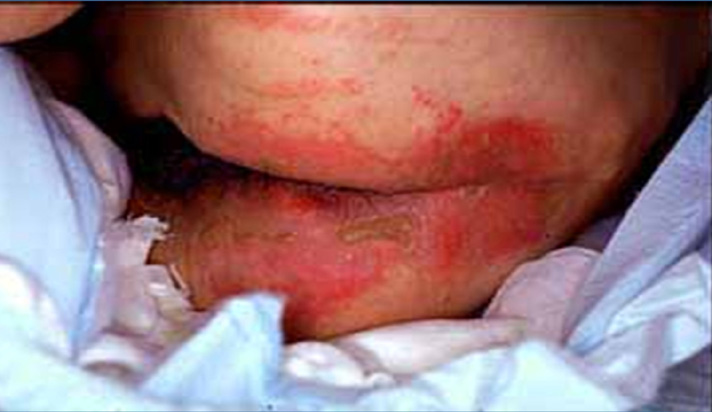
Skin Breakdown #
There are nine risk factors for skin breakdown that will be discussed here. These include:
- Pressure
- Friction
- Shear
- Trauma
- Inadequate Hydration
- Incontinence
- Impaired sensation
- Age
- Inadequate Nutrition
Pressure
Pressure is the first risk factor that will be discussed. The most important point to remember is to protect from prolonged pressure. This means weight shifts and regular turning as required. For bed bound clients, it is recommended to turn every two hours.
What is pressure? Pressure is described in the literature as an equation “Pressure equals force over area.” This means that the greater the force over an area the higher the risk of developing a pressure ulcer. Heels are at risk because they are a small area that bear a lot of weight.
Tissue interface pressure is described as,
The pressure above which tissue cannot be loaded for an indefinite period without resulting in ulceration. Pressure and the duration of pressure application necessary to cause an ulcer have an inverse relationship: Unrelieved axial pressure 4 to 6 times systolic causes necrosis in less than 1 hour; pressure below systolic might not cause similar lesions for as long as 12 hours. Salcido, 2004
In other words, the speed of a pressure ulcer formation directly correlates with the severity of risk.
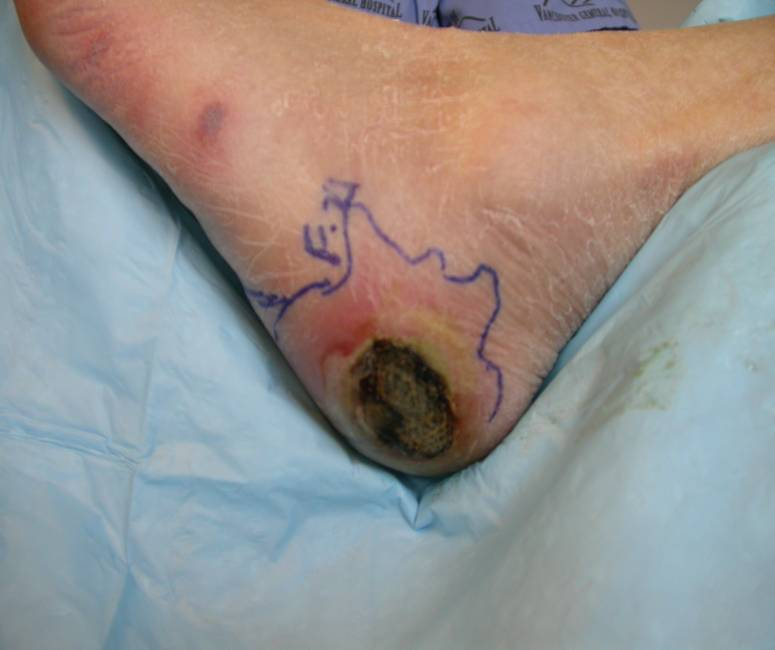
These are examples of pressure ulcers.
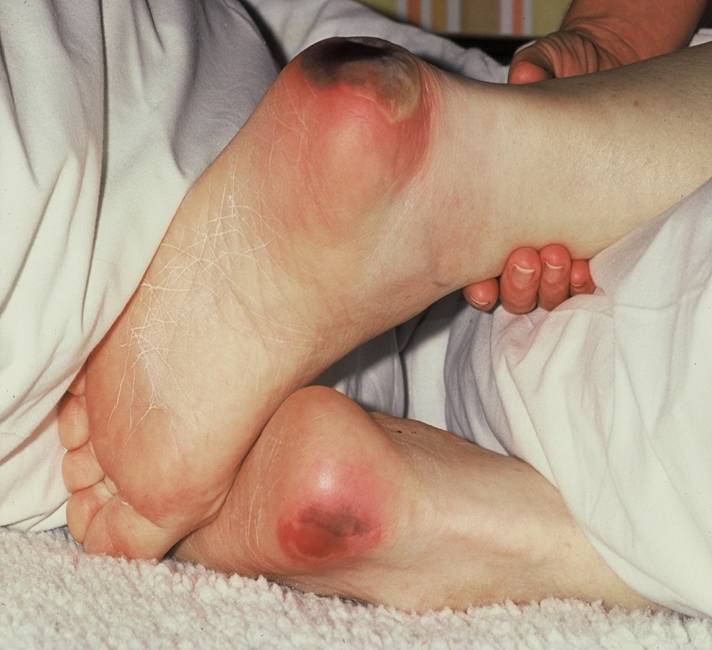
Note the imitation sheepskin. Sheepskin is no longer used because it does not relieve or reduce pressure.
Friction
Rubbing one surface against another causes friction. Its damage is confined to the epidermal and upper dermal layers. Friction damage presents as an abrasion.
Elbows and heels are areas of greatest risk.
Shear
The third risk factor for skin breakdown is shearing.
Shearing occurs from sliding, and as a result, skin moves but the underlying tissue does not. Shearing results in undermining. Undermining is damage that occurs beyond the visible wound margins.
Shearing is most often encountered from sliding in bed or sliding forward in a chair.
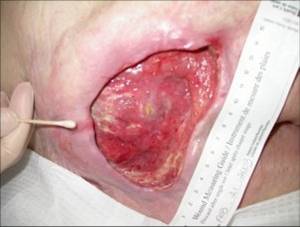
This is a picture of a shear/friction pressure ulcer. This wound undermines from the wound edge up to the clinician’s fingertip. The original size of this wound was 3 X 2 cm, purple and black, however, the damage was extensive once the wound opened.
Trauma
The next risk factor for skin breakdown is how to prevent trauma. Wheelchairs, open cupboards and even hospital beds can be a source of trauma to skin. Throw rugs also are a means of potential trauma as they can be tripping hazards.
This is a picture of a skin tear from a wheel chair. The skin was already at risk from age and dryness.
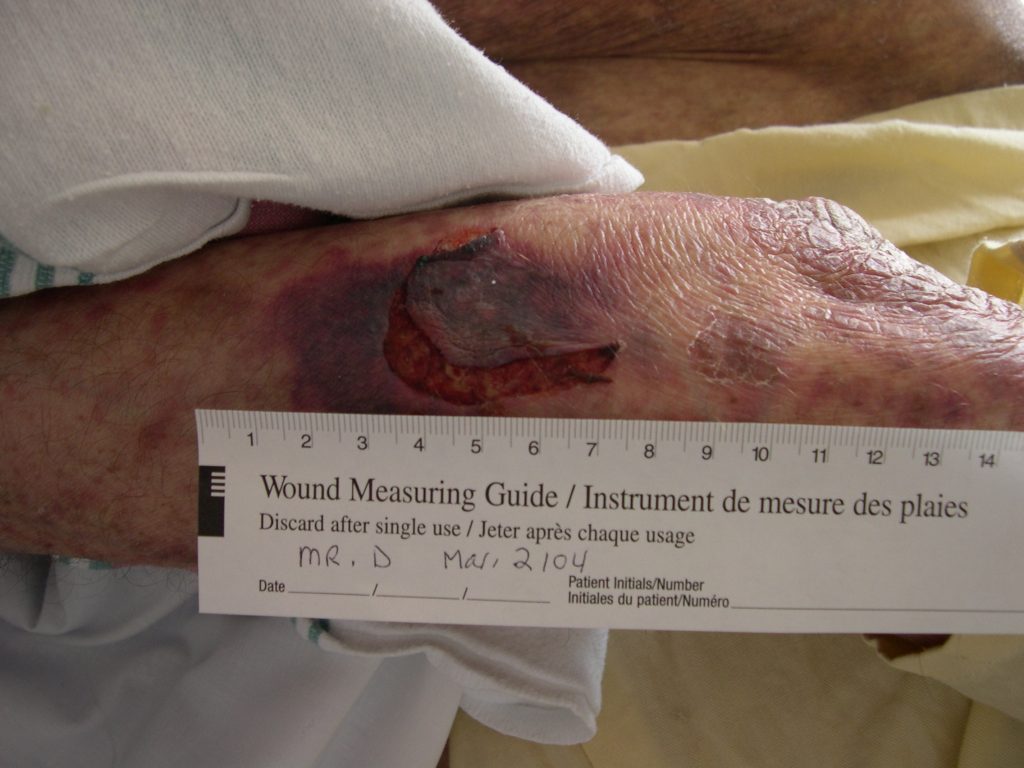
Inadequate Hydration: Maintaining moisture balance
If the skin is too dry, it cracks. If it is too wet, it becomes weak.
Skin that is too moist is a risk factor for skin breakdown because it alters the resiliency of the epidermis to external forces. It also interferes with the process of wound healing, but this will be elaborated on in future units. Skin is often thought of like a brick wall; the bricks being the cells and the mortar being the lipids. When skin is too moist either from water, wound drainage or drainage from other sources, then the mortar becomes weak and soggy. This allows for invading organisms to penetrate skin. When skin is dry, again using the brick and mortar analogy, the mortar or lipids shrink leaving spaces in between the cells allowing the organisms to enter the skin.
Incontinence
Incontinence is also a risk factor for skin breakdown because it not only is a moisture problem, but urine and feces are chemical irritants and can interfere with maintaining skin integrity.
Impaired Sensation
Impaired sensation is also a risk factor. If skin is unable to sense painful stimuli, then it will be slow or unable to communicate the message to move the affected body part away. For example, diabetics with peripheral neuropathy with tight or ill fitting shoes. Damage is done well before it is realized, like at the end of the day when the shoes are removed.
Age
Lastly, age is also a risk factor for skin breakdown for reasons that we discussed previously.
Consider Those at Risk #
Those at risk include:
- Elderly
- People who are incontinent
- People with sensory impairments including:
- Spinal Cord injured patients
- Diabetics
- Stroke patients
- And those with peripheral vascular disease
- Clients confined to bed
- Clients with poor nutritional intake
- Those who require assistance to turn in bed
Not sure who is at risk?
Then do a risk assessment.
This should include consideration of a validated risk assessment tool.
A risk assessment tool can act as a guide to standardized care.
Often protocols can be linked to level of risk. For example if someone is considered a high risk to develop a pressure ulcer, then the protocol may suggest a specialty mattress.
One of the risk assessment tools available is the Braden Scale. The Braden Scale is a globally accepted, scientifically validated tool. However, the Braden Scale is just one tool to help identify those at risk and should be used in conjunction with an overall assessment.
It consists of 6 subscales to identify the level of risk:
- Sensory Perception
- Activity
- Mobility
- Moisture
- Nutrition
- Friction & Shear
The scores identify four risk levels:
- mild
- moderate
- high
- severe
Braden Scale: http://www.bradenscale.com/braden.pdf
This is a picture of the Braden Scale. Many clinicians use it as a guide and for justification when placing patients/clients on a specialty mattress.
Prevention of Skin Breakdown #
Prevention of PressureFirst we will discuss the prevention of pressure. Suggestions include:
- Consult an O.T. for off-loading, if possible
- Another suggestion is to use if possible, pressure reduction or relief surfaces.
- A positioning or turning schedule, developed in conjunction with the client, and posted for the client and care staff to follow. This assists in consistency of care.
Ensure appropriate positioning in bed and in the chair. While in bed, position with a 30-degree lateral rotation as opposed to 90-degree. 30 degrees evens out the areas that will be touching the surface below, thus decreasing area and force. Keep in mind the equation that pressure equals force over area.
- Keep bony prominences separated, such as knees and ankles, using pillows.
- Use a validated risk assessment tool such as the Braden Scale.
- Maintaining nutrition and hydration is key.
- Use a moisture protection such as a barrier ointment.
- Cleanse skin when needed using a pH balanced cleanser.
- Moisturizing the entire body daily.
- And lastly, do not massage red areas.

An important point to remember is to keep heels off-loaded which means pressure free at all times if the person is at risk. This can be done with heel boots that suspend heels in the air, or even pillows. No IV bags please.
Preventing Friction
Preventing friction includes protecting heels and elbows by eliminating irritation of bedclothes, elevating heels off of the bed at all times and by moisturizing heels and elbows well.
Prevention of Shear
Suggestions to help prevent shear include:
- Elevating the head of bed to no more than 30 degrees.
- Using a trapeze if possible.
- Using lift sheets to move or transfer people.
- Avoid layering of sheets in bed and in the chair.
- Consulting the OT or PT if available.
- Using a knee-gatch to minimize sliding down in the bed.
- Ensure correct positioning in a chair. An incorrect slouching position will result in a shearing pressure ulcer eventually for those at risk.
Protection of Moisture Damage
Suggestions to help manage moisture include:
- Treat and/or eliminate the cause if possible.
- Use a moisture barrier such as Proshield, Unisalve or Triple Care.
- Use absorbent pads or briefs that wick and hold moisture.
- Keep moist skin surfaces apart
- Keep skin surfaces separated by using: Gauze, abdominal pads, flannel
- Please do not use Telfa, as Telfa is not designed to absorb moisture, in fact it will keep the moisture in the area, defeating the purpose.
Prevention of Trauma
Suggestions to help prevent trauma include:
- Use a lift sheet for positioning to avoid skin tears or shearing in those at risk.
- Use lifts correctly when transferring.
- Use a falls prevention plan if necessary.
- Keeping skin moisturized.
- Protect from perineal skin injury by using a barrier ointment as required and using appropriate absorbent pads or briefs.
- Also, use palms instead of fingers while turning someone or lifting a limb to avoid the possibility of a skin tear injury.
Managing nutrition and hydration
- Managing nutrition and hydration includes:Consulting the dietitian for assessment if available.
- Protein, protein & more protein. Protein helps to heal wounds. If the protein intake is poor, the body uses its own protein.
- Increasing calories to spare proteins may also be recommended.
- It is also recommended to add a daily multivitamin that includes vitamins A, C, E & zinc.
- If the client is unable to eat the required amount of calories and protein, suggest a liquid diet supplement.
- Monitor their intake and output, or have them do it.
Some examples of the liquid supplementations available are:
- Boost
- Ensure
- Resource
What else can you do? #
Other general care ideas include:
- Maximize mobilization.
- Protect heels. Always off-load. This means no pressure on the heels at anytime if the person is considered at risk.
While they are in bed, the heels should not be touching the bed, even if it is a specialty surface that they are on.
- No massaging of reddened bony prominences.
- No donut-type devices. These may take pressure off of the area you would like, but it puts the pressure else where, causing severe pressure ulcers around the area you originally were wanting to avoid.
- No sheepskins. Again, sheepskin is no longer used because it does not relieve or reduce pressure.
- Use foam wedges to assist in correct positioning.
- Teach small weight shifts. Even just the slightest shift helps redistribute pressure.
- If the head of bed is required to be elevated greater than 30-degrees, for example for feeding, ensure that it is lowered as soon as possible and as soon as it is safe to do so after. Use the knee gatch or pillows under the knees to help minimize sliding.
Summary #
To summarize, prevention is your primary focus. Following the principles of skin integrity help with prevention.
Risk assessment is the key for your protocol choices. Identifying those at risk is one of your first steps in preventing wounds.
Cyber Patient Module
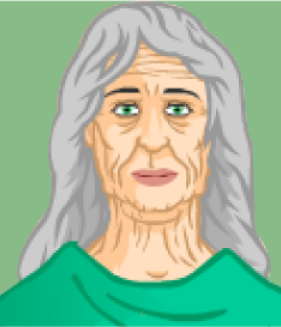
PATIENT PROFILE:
Name: Mrs.Sarah James,
Gender: Female
Age & DOB: 56 years old; 15 June 1967
Setting: Long – term care
Chief Complaint: Pain in the Lumbosacral area
Presenting Symptoms: Pain is due to an Ulcer on the Lumbosacral area, which started 10 days ago and got worse despite outpatient management.S he was admitted to the hospital yesterday.
Previous Medical History: Diabetes, Hypertension, Severe Osteoarthritis
Allergy Status: Seafoods allergy
Investigations
Glucose profile:
Fasting Blood Sugar: 7.5 mmol / L
HbA1c: 8 %
Current Orders:
- Control of vital signs q8h
- Blood glucose before meal and HS
- wound culture stat
- Daily wound dressing change, cleansing the pressure ulcer with a normal saline solution, removing all necrotic tissue, and applying a moisture barrier ointment to the wound bed.Using hydrocolloid dressings
- Acetaminophen 500 mg q8h PRN, considering 2mg hydromorphone PO, PRN before dressing
- Registered dietician consult
- Insulin glargine 10 unit HS and insulin Lispro sliding scale
- lisinopril 5 mg PO, q Am
- Occupational Therapists consult
